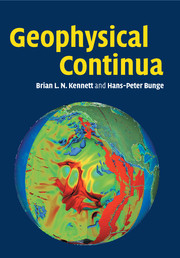Book contents
- Frontmatter
- Contents
- Preface
- 1 Introduction
- PART I CONTINUUM MECHANICS IN GEOPHYSICS
- 2 Description of Deformation
- 3 The Stress-Field Concept
- 4 Constitutive Relations
- 5 Linearised Elasticity and Viscoelasticity
- 6 Continua under Pressure
- 7 Fluid Flow
- 8 Continuum Equations and Boundary Conditions
- PART II EARTH DEFORMATION
- Appendix: Table of Notation
- Bibliography
- Index
2 - Description of Deformation
from PART I - CONTINUUM MECHANICS IN GEOPHYSICS
Published online by Cambridge University Press: 17 March 2011
- Frontmatter
- Contents
- Preface
- 1 Introduction
- PART I CONTINUUM MECHANICS IN GEOPHYSICS
- 2 Description of Deformation
- 3 The Stress-Field Concept
- 4 Constitutive Relations
- 5 Linearised Elasticity and Viscoelasticity
- 6 Continua under Pressure
- 7 Fluid Flow
- 8 Continuum Equations and Boundary Conditions
- PART II EARTH DEFORMATION
- Appendix: Table of Notation
- Bibliography
- Index
Summary
In this Part we will introduce the concepts of continuum mechanics, starting with the description of the geometry of deformation and the notion of strain. We introduce the force field within the continuum through the stress tensor and then link it to the rheological properties of the medium through the appropriate constitutive equations. The treatment is based on the concepts of finite deformation and the results are derived in a general fashion so that the links between the descriptions of solids, fluids, and intermediate properties have a common basis. Having established the general results, we specialise to the important special cases of small deformation in the treatment of linearised elasticity and viscoelasticity. The materials deep within the Earth exist under states of both high pressures and high temperatures so we examine the way in which we can provide a suitable description that can tie to both laboratory experiments and seismological observations. We then treat the evolution of flow in a viscous fluid and the introduction of non-dimensional variables; we present some simple examples including the description of the onset of convection. We bring this Part to a close by bringing together the differential representations of the conservation of mass, momentum and energy with the necessary boundary conditions.
- Type
- Chapter
- Information
- Geophysical ContinuaDeformation in the Earth's Interior, pp. 21 - 40Publisher: Cambridge University PressPrint publication year: 2008



